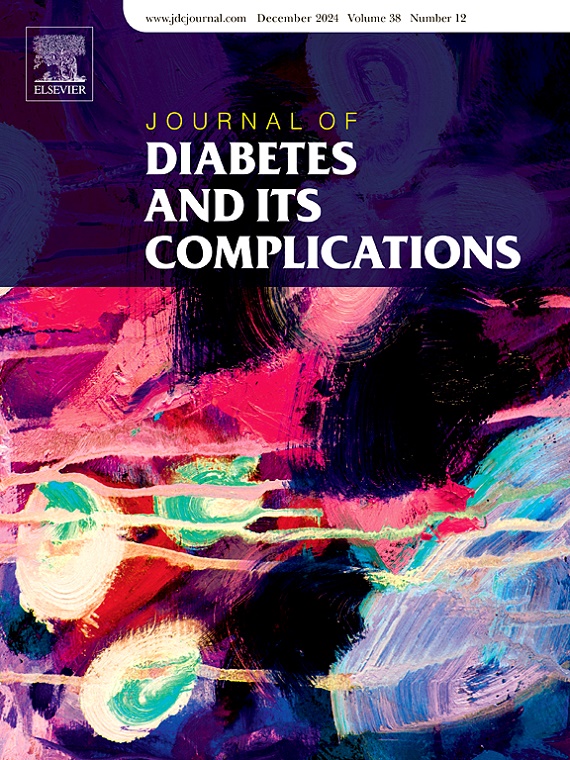Comparison of efficacy and safety of pioglitazone and SGLT2 inhibitors in treating Asian patients in MASLD associated with type 2 diabetes: A meta-analysis
IF 2.9
3区 医学
Q3 ENDOCRINOLOGY & METABOLISM
引用次数: 0
Abstract
Objective
To comprehensively evaluate the therapeutic efficacy of pioglitazone and SGLT2 inhibitors (SGLT2i) in patients with MASLD and Type 2 Diabetes(T2DM).
Methods
Electronic databases, including Web of Science, PubMed, the Cochrane Library, China National Knowledge Internet (CNKI), Wan-Fang Digital Database, and China Science and Technology Journal Database (VIP) were searched from inception to December 2024. Two reviewers independently assessed study eligibility, performed continuous data extraction, and independently evaluated bias risks. Liver ultrasonography, computed tomography (CT), and biochemical indices were utilized to determine the impact of treatment in both groups. Improvement in liver biomarkers and fibrosis as primary outcome indicators; Improvement in body composition, metabolic parameters, glucose parameters, and incidence of adverse effects as a secondary outcome indicator. For continuous variables, mean and standard deviation (SD) were extracted. RevMan 5.4 software was used to systematically analyze the literature, including heterogeneity testing, odds ratios (OR) calculation, and 95 % confidence intervals (CI) for each influencing factor.
Results
Nine randomly controlled trials with 755 Asian participants were included. Our research showed that SGLT2i was more effective than pioglitazone in improving fibrosis-4 score (SMD 0.41 [95%CI 0.18,0.64] p = 0.005), visceral fat area (SMD 0.34 [95%CI 0.14,0.54] p = 0.0007), BMI (SMD 0.29 [95%CI 0.03,0.56] p = 0.03), and low-density lipoprotein levels (SMD 0.21 [95%CI 0.04,0.38] p = 0.01). In contrast, no statistically significant differences were observed in other outcomes.
Conclusions
Our study demonstrated that in patients with MASLD and T2DM, SGLT2i was more effective overall in improving liver fibrosis, blood lipids, liver fat, and body composition in the short term. These findings establish a theoretical basis for safe and rational drug use in clinical practice. Additionally, they may contribute to new insights into the pathogenesis of MASLD and type 2 diabetes and drug discovery and development efforts.
吡格列酮和SGLT2抑制剂治疗亚洲MASLD合并2型糖尿病患者的疗效和安全性比较:一项荟萃分析
目的综合评价吡格列酮联合SGLT2抑制剂(SGLT2i)治疗MASLD合并2型糖尿病(T2DM)的疗效。方法检索Web of Science、PubMed、Cochrane Library、中国知网(CNKI)、万方数字数据库、中国科技期刊库(VIP)等自建库至2024年12月的电子数据库。两名评论者独立评估了研究资格,进行了连续的数据提取,并独立评估了偏倚风险。采用肝脏超声、CT及生化指标评价两组患者治疗效果。改善肝脏生物标志物和纤维化作为主要结局指标;改善身体组成、代谢参数、葡萄糖参数和不良反应发生率作为次要结局指标。对于连续变量,提取均值和标准差(SD)。采用RevMan 5.4软件对文献进行系统分析,包括异质性检验、优势比(OR)计算和各影响因素95%置信区间(CI)。结果纳入9项随机对照试验,共755名亚洲受试者。我们的研究表明,SGLT2i在改善纤维化-4评分(SMD 0.41 [95%CI 0.18,0.64] p = 0.005)、内脏脂肪面积(SMD 0.34 [95%CI 0.14,0.54] p = 0.0007)、BMI (SMD 0.29 [95%CI 0.03,0.56] p = 0.03)和低密度脂蛋白水平(SMD 0.21 [95%CI 0.04,0.38] p = 0.01)方面比吡格列酮更有效。相比之下,在其他结果中没有观察到统计学上的显著差异。结论我们的研究表明,在MASLD合并T2DM患者中,SGLT2i在短期内总体上更有效地改善肝纤维化、血脂、肝脂肪和体成分。这些发现为临床安全合理用药奠定了理论基础。此外,它们可能有助于对MASLD和2型糖尿病的发病机制和药物发现和开发工作的新见解。
本文章由计算机程序翻译,如有差异,请以英文原文为准。
求助全文
约1分钟内获得全文
求助全文
来源期刊

Journal of diabetes and its complications
医学-内分泌学与代谢
CiteScore
5.90
自引率
3.30%
发文量
153
审稿时长
16 days
期刊介绍:
Journal of Diabetes and Its Complications (JDC) is a journal for health care practitioners and researchers, that publishes original research about the pathogenesis, diagnosis and management of diabetes mellitus and its complications. JDC also publishes articles on physiological and molecular aspects of glucose homeostasis.
The primary purpose of JDC is to act as a source of information usable by diabetes practitioners and researchers to increase their knowledge about mechanisms of diabetes and complications development, and promote better management of people with diabetes who are at risk for those complications.
Manuscripts submitted to JDC can report any aspect of basic, translational or clinical research as well as epidemiology. Topics can range broadly from early prediabetes to late-stage complicated diabetes. Topics relevant to basic/translational reports include pancreatic islet dysfunction and insulin resistance, altered adipose tissue function in diabetes, altered neuronal control of glucose homeostasis and mechanisms of drug action. Topics relevant to diabetic complications include diabetic retinopathy, neuropathy and nephropathy; peripheral vascular disease and coronary heart disease; gastrointestinal disorders, renal failure and impotence; and hypertension and hyperlipidemia.
 求助内容:
求助内容: 应助结果提醒方式:
应助结果提醒方式:


